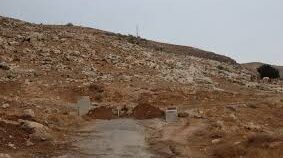War and annexation: How the Israeli government changed the West Bank during the first year of war

The blocked entrance to the village of Ein Samia, northeast of Nablus
Peace Now introduces a report on the West Bank on 13 October 2024:
After a year of war in Gaza and nearly two years under an extreme right-wing, pro-settler government, the Israeli government’s policy in the occupied West Bank has become fully apparent: annexing the West Bank and shrinking Palestinian space in Area C.
This policy is being carried out through the establishment of a record number of illegal outposts, a sharp increase in the quantity and intensity of settler violence—described by the head of the General Security Service (Shin Bet) as Jewish terrorism—closures of roads and highways, and unprecedented measures to legalize and fund illegal outposts. At the same time, the government is completing an administrative infrastructure for the annexation of the West Bank, by transferring powers from the Civil Administration, a military body, to the newly created Settlement Administration, a civil and political administration under the direct authority and control of Minister Smotrich.
Current Situation in the West Bank Under Netanyahu’s Government Since 10/7/23
Settlements and Outposts:
– At least 43 new outposts have been established, most of which are agricultural outposts (“farms”) focused on land takeover and the systematic expulsion of Palestinians from the area. The number of new outposts is unprecedented. For instance, from 1996 until early 2023, fewer than 7 outposts were established per year on average.
– Numerous unauthorized new roads have been constructed, with a total length estimated at dozens of kilometers, to facilitate the establishment of new outposts and take control of additional land.
– The Higher Planning Council advanced plans for 8,681 housing units in settlements.
– 24,193 dunams were declared as “state land,” amounting to approximately half of all the land declared as state land since the Oslo agreement (1993) to date.
– The cabinet decided to establish five new settlements: Evyatar, Givat Assaf, Sde Efrayim, Adorayim, and the Nahal Heletz settlement. All five are currently illegal outposts which will now become official settlements.
– Three outposts were designated as “neighborhoods” of existing settlements through plan approvals by the Higher Planning Council: Machane Gadi, Kedem Arava, and Givat Chanan.
– 70 illegal outposts were recognized as eligible for funding and infrastructure. Minister Smotrich instructed government ministries and other authorities to begin funding these 70 illegal outposts, as well as construct public buildings in them, and connect them to water, electricity, and other utilities.
– New settlements in Hebron—settlers have entered a house in Hebron that they claim to have purchased from Palestinians. Their entry was made possible after they received a “transaction permit” from entities subordinate to Minister Smotrich. Additionally, a plan to establish a new settlement enclave in Hebron with 234 housing units north of Kiryat Arba has been deposited for public review.
Funding and Budgets:
– The government doubled the budget of the Ministry of Settlement and the funds allocated to the Settlement Division, adding 302 million shekels.
– 7 billion shekels were allocated for roads in the settlements. According to Minister Smotrich, the Ministry of Finance has reached an agreement with the Ministry of Transportation on a five-year plan totaling 7 billion shekels for intercity roads between the settlements.
